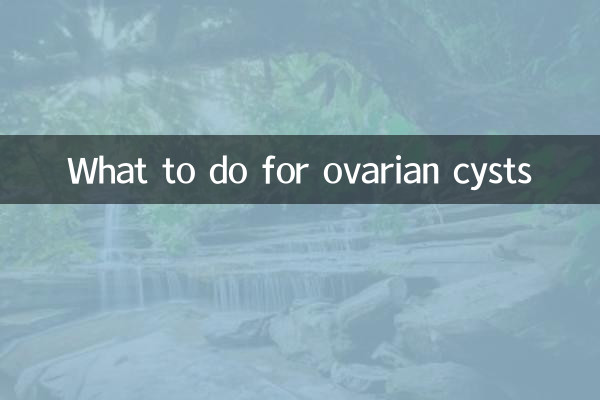What to do for ovarian cysts
Ovarian cysts are one of the common gynecological diseases in women. They may have no obvious symptoms in the early stage, but they can be discovered and treated in a timely manner through scientific examination methods. This article will introduce in detail the common examination methods for ovarian cysts, and combine popular topics and hot content in the past 10 days to help women better understand this disease.
1. Common examination methods for ovarian cysts

Examination of ovarian cysts mainly includes imaging examinations, laboratory examinations and pathological examinations. The following are the specific inspection items and their functions:
| Check items | Check content | effect |
|---|---|---|
| Ultrasound examination | Observe ovarian morphology, cyst size and properties through B-ultrasound or negative ultrasound | Preliminary judgment on whether the cyst is benign or malignant |
| Blood test | Detect tumor markers such as CA125 and HE4 | Assist in determining whether the cyst is malignant |
| CT or MRI | High resolution image inspection | Further clarify the location, size and relationship with surrounding tissues |
| Laparoscopy | Minimally invasive surgery, direct observation of ovaries and cysts | Confirmed cyst nature, and surgery can be performed simultaneously if necessary |
2. The association between popular topics and ovarian cysts in the past 10 days
Recently, discussions on women's health have been high, especially early screening and prevention of ovarian cysts. Here are some hot topics:
1."Does asymptomatic ovarian cysts need treatment?": Many women find ovarian cysts during physical examinations, but there are no discomfort symptoms. Experts recommend that even if there is no symptoms, regular review should be performed to avoid worsening of the cyst.
2."The incidence of ovarian cysts in young women": Data shows that the incidence of ovarian cysts in women aged 20-30 has increased, which may be related to factors such as life stress and eating habits.
3."The relationship between ovarian cysts and infertility": Some ovarian cysts may affect fertility function, especially endometriosis cysts (chocolate cysts).
3. How to choose the inspection method that suits you?
Depending on the nature of the cyst and personal condition, the doctor will recommend different examination methods. Here are the reference suggestions when choosing a check method:
| crowd | Recommended check | Things to note |
|---|---|---|
| First time cyst found | Ultrasound + Blood test | Priority for non-invasive examination |
| Large or suspected malignant | CT/MRI + laparoscopy | Further diagnosis is required |
| Pregnant women | Ultrasound + hormone level test | Focus on the effects of cysts on fertility |
4. Daily prevention and precautions for ovarian cysts
1.Regular physical examinations: It is recommended to undergo gynecological examination once a year, especially ultrasound examination.
2.Healthy Eating: Reduce the intake of high-fat and high-sugar foods and eat more fresh fruits and vegetables.
3.Regulate emotions: Long-term stress may affect the endocrine and increase the risk of cysts.
4.Avoid sitting for a long time: Moderate exercise can help promote pelvic blood circulation.
5. Summary
There are various methods for examination of ovarian cysts, and appropriate examination methods should be selected according to personal circumstances. Recent hot topics also remind women to pay attention to ovarian health, and early detection and early treatment are the key. If you have relevant symptoms or concerns, it is recommended to seek medical treatment in time and follow the advice of a professional doctor.

check the details

check the details